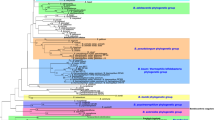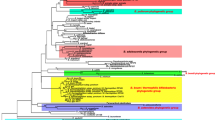Abstract
Bifidobacteria are considered key commensals of the human intestinal tract; they dominate the community in the earliest stages of life and are the first to respond to stress factors. The metasequencing of the V3–V4 16S rRNA fragments made it possible to identify 12 phylotypes of bifidobacteria in the gut microbiome of adolescents, which accounted for from 0.0001 to 0.9% of the total microbiome. A phylogenetic analysis of the obtained phylotypes was conducted; such species as B. angulatum, B. bifidum, B. longum, and B. animalis, as well as subspecies B. animalis subsp. lactis, were identified. The species of bifidobacteria excluded from identification by the V3–V4 variable regions were identified. The phylogenetic analysis of different variable regions and their combinations showed that a tree topology based on the V2 fragment is the most similar to a tree topology based on the complete gene.





Similar content being viewed by others
REFERENCES
Turroni, F., Milani, C., Van Sinderen, D., and Ventura, M., Bifidobacteria: ecology and coevolution with the host, in The Bifidobacteria and Related Organisms: Biology, Taxonomy, Applications, New York: Acad. Press, 2018, pp. 213—220. https://doi.org/10.1016/B978-0-12-805060-6.00012-0
Ventura, M., Canchaya, C., Tauch, A., et al., Genomics of actinobacteria: tracing the evolutionary history of an ancient phylum, Microbiol. Mol. Biol. Rev., 2007, vol. 71, no. 3, pp. 495—548. https://doi.org/10.1128/MMBR.00005-07
Turroni, F., van Sinderen, D., and Ventura, M., Genomics and ecological overview of the genus Bifidobacterium,Int. J. Food Microbiol., 2011, vol. 149, no. 1, pp. 37—44. https://doi.org/10.1016/j.ijfoodmicro.2010.12.010
Turroni, F., Peano, C., Pass, D.A., et al., Diversity of bifidobacteria within the infant gut microbiota, PLoS One, 2012, vol. 7, no. 5. e36957. https://doi.org/10.1371/journal.pone.0036957
Rakova, E.B., Nemchenko, U.M., Popkova, S.M., et al., Species characteristics of bifidobacteria in the intestinal biotope of children with functional dyspepsia, Klin. Lab. Diagn., 2015, vol. 60, no. 10, pp. 50—53.
Nemchenko, U.M., Savel’kaeva, M.V., Rakova, E.B., et al., Microecological characteristics of intestinal biocenosis in children with functional disorders of the gastrointestinal tract, Klin. Lab. Diagn., 2016, vol. 61, no. 6, pp. 368—371.
Grigorova, E.V., Rakova, E.B., Savel’kaeva, M.V., et al., Disadaptive rearrangement of the large intestine microbiocenosis in 3—6 months old children under the influence of bacteria of the genus Klebsiella,Zh. Infektol., 2017, vol. 9, no. 1S, p. 58.
Grigorova, E.V., Ivanova, E.I., Nemchenko, U.M., and Savel’kaeva, M.V., Detection of pathogenicity factors in strains of Klebsiella spp. as the main etiological agent in the formation of functional gastrointestinal disorders in infants, Zh. Infektol., 2018, vol. 10, no. S4-1, p. 70.
Rakova, E.B., Popkova, S.M., Nemchenko, U.M., et al., Specific characteristics of microbiocenoses in children living under conditions of technogenic pressure, Gig. Sanit., 2011, no. 4, pp. 22—26.
Nemchenko, U.M., Rakova, E.B., Popkova, S.M., et al., The structure of intestinal dysbiosis in preschool children over a long-term observation period, Klin. Lab. Diagn., 2015, vol. 60, no. 2, pp. 63—65.
Nemchenko, U.M., Microecological status of intestinal biocenosis and species architectonics of bifidobacteria in children, Extended Abstract of Cand. Sci. Dissertation, Nauchnyi Tsentr Problem Zdorov’ya Sem’i i Reproduktsii Cheloveka Sibirskogo Otdeleiya Rossiiskoi Akademii Meditsinskikh Nauk, Irkutsk, 2014, p. 20.
Lagier, J.-C., Million, M., Hugon, P., et al., Human gut microbiota: repertoire and variations, Front. Cell. Infect. Microbiol., 2012, vol. 2, p. 136. https://doi.org/10.3389/fcimb.2012.00136
Rinke, C., Schwientek, P., Sczyrba, A., et al., Insights into the phylogeny and coding potential of microbial dark matter, Nature, 2013, vol. 499, no. 7459, pp. 431—437. https://doi.org/10.1038/nature12352
Yang, B., Wang, Y., and Qian, P.Y., Sensitivity and correlation of hypervariable regions in 16S rRNA genes in phylogenetic analysis, BMC Bioinf., 2016, vol. 17, no. 135. PMC4802574. https://doi.org/10.1186/s12859-016-0992-y
Billera, L.J., Holmes, S.P., and Vogtmann, K., Geometry of the space of phylogenetic trees, Adv. Appl. Math., 2001, vol. 27, no. 4, pp. 733—767. https://doi.org/10.1006/aama.2001.0759
Owen, M. and Provan, J.S., A fast algorithm for computing geodesic distances in tree space, IEEE/ACM Trans. Comput. Biol. Bioinf., 2011, vol. 8, no. 1, pp. 2—13. https://doi.org/10.1109/TCBB.2010.3
Belkova, N.L., Nemchenko, U.M., Pogodina, A.V., et al., Composition and structure of gut microbiome in adolescents with obesity and different breastfeeding duration, Bull. Exp. Biol. Med., 2019, vol. 167, no. 6, pp. 759—762. https://doi.org/10.1007/s10517-019-04617-7
Bolyen, E., Rideout, J.R., Dillon, M.R., et al., Reproducible, interactive, scalable, and extensible microbiome data science using QIIME 2, Nat. Biotechnol., 2019, vol. 37, no. 8, pp. 852—857. https://doi.org/10.1038/s41587-019-0209-9
Callahan, B.J., McMurdie, P.J., Rosen, M.J., et al., DADA2: high-resolution sample inference from Illumina amplicon data, Nat. Methods, 2016, vol. 13, no. 7, p. 581. https://doi.org/10.1038/nmeth.3869
Raaijmakers, J.G., Statistical analysis of the Michaelis—Menten equation, Biometrics, 1987, vol. 43, no. 4, pp. 793—803. https://doi.org/10.2307/2531533
Thompson, J.D., CLUSTAL W: improving the sensitivity of progressive multiple sequence alignment through sequence weighting, position-specific gap penalties and weight matrix choice, Nucleic Acids Res., 1994, vol. 22, no. 22, pp. 4673—4680. https://doi.org/10.1093/nar/22.22.4673
Hillis, D.M. and Bull, J.J., An empirical test of bootstrapping as a method for assessing confidence in phylogenetic analysis, Syst. Biol., 1993, vol. 42, no. 2, pp. 182—192. https://doi.org/10.1093/sysbio/42.2.182
Sun, Z., Zhang, W., Guo, C., et al., Comparative genomic analysis of 45 type strains of the genus Bifidobacterium: a snapshot of its genetic diversity and evolution, PLoS One, 2015, vol. 10, no. 2. e0117912. https://doi.org/10.1371/journal.pone.0117912
Alcon-Giner, C., Caim, S., Mitra, S., et al., Optimisation of 16S rRNA gut microbiota profiling of extremely low birth weight infants, BMC Genomics, 2017, vol. 18, no. 1, p. 841. https://doi.org/10.1186/s12864-017-4229-x
Walker, A.W., Ince, J., Duncan, S.H., et al., Dominant and diet-responsive groups of bacteria within the human colonic microbiota, ISME J., 2011, vol. 5, no. 2, pp. 220—230. https://doi.org/10.1038/ismej.2010.118
Author information
Authors and Affiliations
Corresponding author
Ethics declarations
Statement of compliance with standards of research involving humans as subjects. All procedures performed in a study involving people comply with the ethical standards of the institutional and/or national committee for research ethics and the 1964 Helsinki Declaration and its subsequent changes or comparable ethical standards.
Informed voluntary consent was obtained from each of the participants.
Conflict of interest. The authors declare that they have no conflict of interest.
Supplementary material
Rights and permissions
About this article
Cite this article
Klimenko, E.S., Pogodina, A.V., Rychkova, L.V. et al. The Ability of Taxonomic Identification of Bifidobacteria Based on the Variable Regions of 16S rRNA Gene. Russ J Genet 56, 926–934 (2020). https://doi.org/10.1134/S1022795420080074
Received:
Revised:
Accepted:
Published:
Issue Date:
DOI: https://doi.org/10.1134/S1022795420080074




